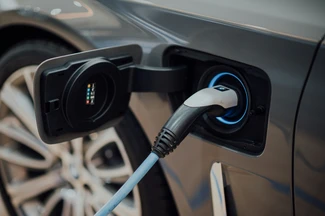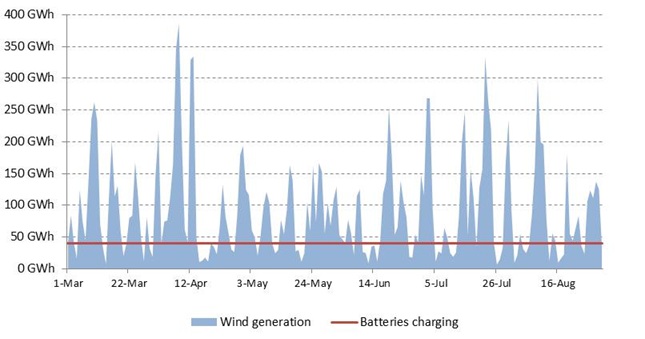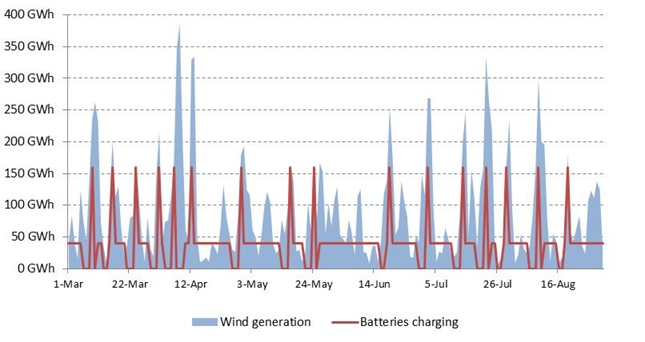See also

Electric Vehicles’ deployment: will it reach expected targets?
The European Union (EU) has set a target of carbon neutrality by 2050, in line with the Paris Agreement, as well as an intermediate target of a net reduction in domestic greenhouse gas (GHG) emissions of at least 55% by 2030 compared to 1990.
Road transport plays a key role in achieving these targets. This executive brief explores the factors driving the sales of electric vehicles (EVs) in the EU.
Development of wind power has been important in recent years and this trend is expected to continue. More and more, this source of energy represents a significant share in the energy balances of several European countries. But variability of wind power remains a major challenge of this technology. For example, a wind turbine can start producing in the middle of the night when electricity demand is very low. Statistically, we can also observe that production of wind turbines is slightly higher at night than during the day. Electric vehicles are one of the solutions put forward to manage the wind energy variability. Thanks to their batteries, electric vehicles may offer an important reservoir at a country level. With 160 km autonomy, an electric vehicle can store up to 40 kWh. This energy is sufficient to run 4 days without recharging, assuming that a vehicle consumes 0.25 kWh per km and runs in average 40 km per day. Can electric vehicles make a significant contribution to manage the consequences of the variability of wind on the electricity system?
Wind generation versus storage capacity offered by electric vehicles: which orders of magnitude
Obviously, this question is highly dependent on the national situations as regard wind electricity generation in the one side, development of the electric vehicles in the other side. But to illustrate the nature of the issue, and how far wind power and electric vehicles are complementary, we will take a specific example of a large country with high wind power capacity installed and large potential for electric vehicles development: Germany. The graph below shows the current wind power profile in Germany and a hypothetic situation with 4 million electric vehicles (including plug-in hybrids). In this graph, the red line shows the daily electricity requirement to reload electric vehicles if they reload whenever they can. In other words, if there is no "smart" vehicle load across the week. Without specific strategy, electric vehicles are reloaded each day on average for one fourth of their loading capacity. The good news is that wind production might be enough to reload electric vehicles most of the year round. The bad news is that the reloading of batteries does not really smooth the consequences of major wind peaks. Over a 6 month period, there would still be around 23 strong windy days when available wind power would exceed the demand of electric vehicles by 150 GWh or more.
Daily wind generation in Germany in 2011 and flat EV charging

Source: Enerdata
Smart loading management may improve the complementarity between wind power and electric vehicles
Indeed, there might be a smarter way to reload electric vehicles, by taking into account weather forecasts and anticipation of wind peaks. The purpose would be to make sure that the batteries of the vehicles are almost empty on average just before strong windy conditions, and can then be mostly reloaded during the windy period. This management assumes that people do not rush to reload every time they can, and accept sometimes to drive with batteries not fully loaded. Reload can then be optimized and synchronized to strong wind peaks. The graph below shows the results of such a better management in the German case study. The situation would improve slightly, however the largest wind production peaks still overcome by large the demand of electric vehicles. In this case, medium peaks are much better addressed, but the larger ones still raise problems. Indeed, when the wind is strong and lasts for several days, the first day can be smoothed effectively, but the days after not so much, as batteries are at least 75% full, limiting the opportunity to reload. Having several continuous days of wind is a common situation. In this case, there are still 20 days when available wind power on the grid exceeds by 150 GWh the daily electricity requirement to reload the vehicles.
Wind generation in Germany in 2011 and dynamic EV charging (smart charging)

Source: Enerdata
This can be even further improved if batteries are also used to store electricity for the grid: it can help implementing the smart loading management (batteries are discharged on the grid just before windy conditions), and it can help tapping more on wind electricity to reload the batteries (in particular in periods when wind intermittency is strong). Although the consequences of such a use of batteries have not been calculated in details, it seems that this would not change drastically the observations made above.
Conclusion
The German case described here suggests that the development of electric vehicles might not make a significant contribution to electricity supply/demand balancing problems in strong windy days, at least for the next 10 to 15 years, in countries with large wind power potentials. A clever management of batteries reloading, as well as a use of batteries to supply the grid at peak hours may improve the situation during this period, but probably not too much.
 Energy and Climate Databases
Energy and Climate Databases Market Analysis
Market Analysis